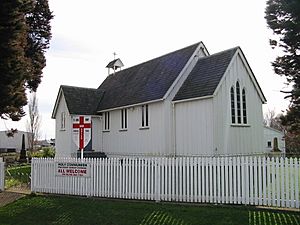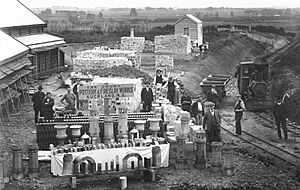Drury, New Zealand facts for kids
Quick facts for kids
Drury
|
|
|---|---|
|
Suburb
|
|

St John's Church, Drury
|
|
| Country | New Zealand |
| Local authority | Auckland |
| Electoral ward | Manurewa-Papakura ward |
| Local board | Papakura Local Board |
| Area | |
| • Land | 591 ha (1,460 acre) |
| Population
(June 2023)
|
|
| • Total | 1,560 |
|
|
||
Drury is a rural town located near Auckland in New Zealand. It's about 36 kilometers south of Auckland CBD, which is the city center. Drury is managed by the Auckland Council. It sits at the southern edge of Auckland's main city area, about 12 kilometers northeast of Pukekohe. It is also close to the Papakura Channel, which is part of the Manukau Harbour.
Contents
What's in a Name?
Drury got its name from Commander Byron Drury. He was the captain of a ship called HMS Pandora. In 1853, he explored and mapped the Manukau Harbour.
Drury's Past: A Look at History
Drury has a rich history! One of its first big industries was coal mining, which started in the 1850s. A company called Waihoihoi Mining and Coal Company was formed in 1859.
- Early Transport
Because coal mining was successful, one of New Zealand's very first tramways opened in 1862. A tramway is like a small railway. This one was 5.2 kilometers long. It helped transport coal to Slippery Creek, where it could be shipped to Onehunga.
- Bricks and Pottery
Another important early industry in Drury was making bricks and pottery. There was a large factory that made these items. It was connected to a nearby quarry by another tram line. This brick and pottery business was active until at least 1928.
- New Zealand Wars
Drury was a key spot for British soldiers during the New Zealand Wars. These wars were conflicts between the British and Māori people in the 19th century. General Duncan Cameron set up a camp for soldiers in Drury. These soldiers also helped build an extension of the Great South Road further south.
- Changes in Local Government
In 1989, there was a big change in how local areas were governed. Drury became part of the Auckland Region. It was also part of the southern edge of the Papakura District. Before this, it was known as Franklin County.
Drury used to be a small, quiet rural area at the foot of the Bombay Hills. But as Auckland has grown, Drury has become a southern suburb. It's now close to where State Highways 1 and 22 meet, which both head south towards the Waikato region.
In 2010, the entire Auckland Region changed again. All the smaller local councils, including Papakura and Franklin Districts, joined together to form one big council: the Auckland Council. Drury became part of the Franklin ward, which is one of the council's thirteen areas.
Drury's Future: Growing and Developing
Drury is growing fast! Auckland's largest business park is being built in the south of Drury. This park is expected to create jobs for about 6,900 people. Also, around 2,500 new homes are planned for the west of Drury, and construction is already happening.
In 2020, people were discussing how big these developments would be and how much the Auckland Council would contribute.
Who Lives in Drury? Demographics
Drury covers an area of about 5.91 square kilometers. As of 2023, it has an estimated population of about 6,000 people. This means there are about 1,000 people living in each square kilometer.
In 2018, Drury had a population of 1,197 people. There were slightly more females than males. The average age was 36 years old. About 20% of the people were under 15 years old.
- Diversity in Drury
Drury is a diverse place!
- About 74% of people are European/Pākehā.
- About 23% are Māori.
- About 10% are Pacific peoples.
- About 11% are Asian.
- A small percentage are from other ethnic groups.
- About 21% of people living in Drury were born outside New Zealand.
- Beliefs and Work
Many people in Drury (about 49%) say they have no religion. About 38% are Christian. Other religions like Hindu, Muslim, and Buddhist are also present.
When it comes to work, about 55% of people aged 15 and over work full-time. About 14% work part-time. The average income in Drury was $38,500.
Learning in Drury: Schools
Drury has several schools for young people:
- Drury School is a primary school for students in years 1 to 8. It opened in 1857 and has about 600 students.
- Drury Christian School is a private school for students from years 1 to 13. It has about 100 students.
Both these schools welcome both boys and girls.
A new school, St Ignatius of Loyola Catholic College, is planned to open in Drury in 2024. It will be a secondary school and the 15th Catholic College in Auckland. New homes will also be built near the college.
Important Buildings
- St Johns' Church (Anglican)




